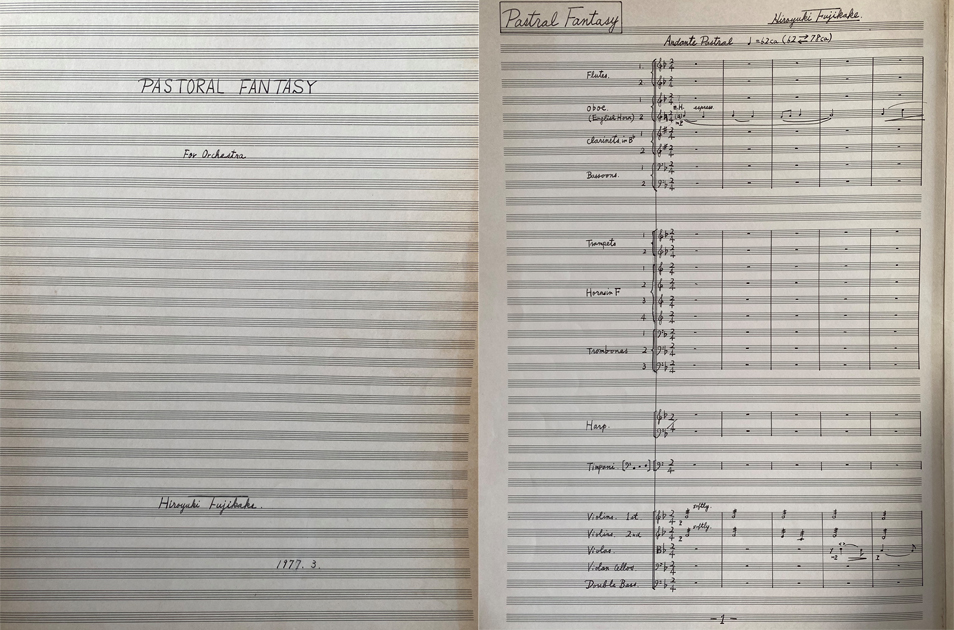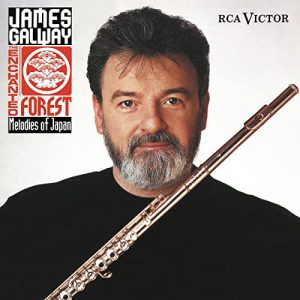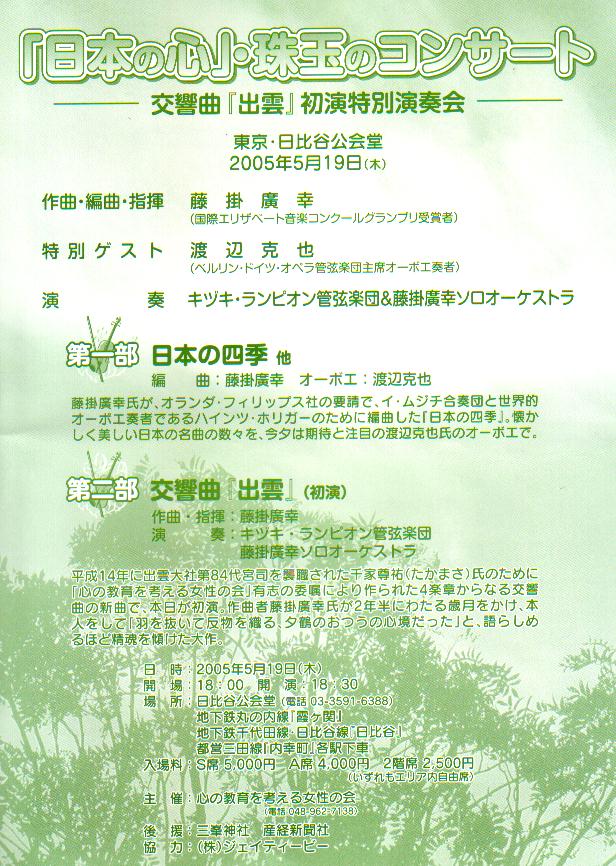Pastoral Fantasy Work Description
The most popular mandolin music since the Japan Mandolin Union (JMU) Competition for composition started.
Contents
Pastoral Fantasy was composed in 1975
1st the Japan Mandolin Union(JMU) Competition for composition-2nd Prize (no 1st prize awarded)
(English・Japanese)Pastoral Fantasy
(Italian) Fantasia Pastorale
(Frence) Fantaisie pastorale
The Following is Fujikake’s handwriting work description for Pastoral Fantasy, written in 10th, October 1975.

Please use the following for your program↓
It was the second work Hiro composed for mandolin orchestra. The work was composed in June and July of 1975 and was first performed by the Tokai Student Mandolin Association in August. The inspiration for this music came from the fresh greenery of early summer. The title “Pastoral Fantasy” suggests the idea of pastoral scenery, an image evoked by the theme of the music. The form of the music is as follows:
- Introduction of pastoral theme, andante
- Fugal section, free development
- Recap of the touching pastoral theme
- Powerful coda
However, rather than interpreting the music according to a pre-defined theme, listeners are invited to listen and appreciate freely. It would be great pleasure for the composer if this music means something to those who play or listen to it.
How do we play Pastoral Fantasy
The following was excerpted and translated from Hiro Fujikake’s comments in the seminar discussion about “Pastoral Fantasy”, on December 26, 2009.
To be honest, I composed Pastoral Fantasy when I was not fully aware of the mandolin’s performance technique. Now, I’m hoping that it will be performed using the mandolin’s unique approach to “picking” and “tremolo.” Normally, composers describe intended musical interpretation on their sheet music. However, this is only a general guideline. If we write more details like “accent here,” “need more accent,” “tenuto here” and so on, the sheet music would become pitch black. Even if there was enough space, it wouldn’t be possible to help performers with all details. Of course, it’s important to perform accurately in accordance with sheet music, but symbols are just symbols – nothing more, nothing less. If you find “p” on a score, does it mean you perform with only “piano”? Or, if you find “cresc.,” would you rather choose not to play with “crescendo”? This is not what it’s all about. Sheet music is just a bunch of symbols, and it does not have a life or a heart. As a composer, I would like performers to think and imagine what a composer really wanted to express in their music by reading musical scores. When you find “f,” it’s better to consider whether the composer would have imagined that “cresc.” was necessarily in front. Or if there is no “rit.,” the composer might have wanted it to be performed with “rit..” Your imagination and sensitivity will create real music. For instance, performers naturally want to play with “accel.,” although nothing has been written on the scores of Mozart or Beethoven. However, it’s not just the performers’ idea to accelerando.
If you pay attention to a scene in films or TV dramas, you would realize what I really want to tell you. For instance, a sentence on a script for a male actor might say, “Today it is raining.” Is this line just after a scene of something good happening? Or just after he is fired from the company? The actor has to consider the feeling of the man in his situation. What’s important for performers is to read the feeling of composers from scores. Of course, there are many interpretations depending on players. The performance will happen just once, and each performance will create new life in the music and it disappears immediately after the performance. Especially for an orchestra, each part will be performed with the same instruments. However, performers will feel differently even though they are reading the same score, and I think it’s very natural because everyone has different feelings. If they all have the same feeling they aren’t acting as human beings. In that case computers can perform instead and that’s not what people want to listen to and share. The job of a conductor is guiding everyone in the same direction and naturally accepting that each performer has different interpretations of the conductor’s direction. Music will come alive if a conductor shows a direction, and the diversity of performers’ feelings moves the audience. The performance is just for one time and the delighted excitement won’t be repeated. Music is alive. That’s why it’s wonderful.
Pastoral Fantasy has been written in different styles
| Mandolin Orchestra Pastoral Fantasy(066) The Original Version. |
 |
| Mandolin Orchestra ★Pastoral Fantasy (066B) 10 min, Shot Version. |
 |
| Mandolin Orchestra Fl & Cl Added Pastoral Fantasy(067) 【Added Fl.Cl.Percussion】 Flute and Clarinet has been added to the Original Version. |
 |
| Mandolin Orchestra 2010 Complete edition: Pastoral Fantasy(103) 【Added Fl.Cl.Percussion】With elaborations on the details of playing technique and in order to be performed more easily, it’s been totally rewritten from the original (066). Even a 6-piece mandolin ensemble is able to make more effective sounds with this score than the original. Wind instrument parts and percussion can be omitted. It was first performed Keio University’s 100th anniversary in 2010. |
|
| Mandolin Orchestra Pastoral Fantasy with Violin(111) For Violin Solo and Mandolin Orchestra. Commissioned by Nippon Music Foundation.It was first performed at 11th ARTE Int’l Mandolin Festival and Competition in 8th October,2017 with Stradivarius.Vn : Yuki Manuela Janke Conductor : Hiroyuki Fujikake Stradivarius 1736 Violin “Muntz” on loan from Nippon Music Foundation Orchestra : ARTE MANDOLINISTICA & ARTE TOKYO & Studends of Junior High-school & High School in Kansai region |
 |
Pastoral Fantasy for Symphony Orchestra
This version of Pastoral Fantasy, originally for mandolin orchestra, was written for symphony orchestra in March 1977 and first performed by the Nagoya Philharmonic Orchestra, conducted by Yuzo Toyama. Only handwritten sheet music exists, and there is no record of performance since 1977 unfortunately. Hopefully it will be performed by symphony orchestra again in the future.

Work Description for “Pastoral”
This short piece is adapted from the “Andante part” of Pastoral Fantasy, originally for a large mandolin orchestra. This is written with a simplified technique so that small ensembles can enjoy it. There is no fugue in this music, and the melody is smooth and cosy. This work is also arranged for piano solo, mandolin solo & piano, and for flute & piano.



